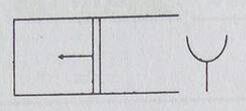Sound waves from a tuning fork placed at a point P reach another point Q , by two separate paths PRQandPSQ . When PSQ is greater than PRQby11.5cm , there is silence at Q . When the difference is 23cm , the sound becomes loudest at Q, and when 34.5cm , there is silence , and so on . Explain this effect and calculate the frequency of the fork if the velocity of sound is taken to be 331.2m/s.
Path difference from one minimum to the next minimum is λ. Here path difference from one minimum to the next minimum is 23.0cm.λ=23.0cm=0.23m.
C=nλ
or n=331.20.23=1440Hz
Topper's Solved these Questions
- BOOK - CENGAGE PHYSICSCHAPTER - SUPERPOSITION AND STANDING WAVESEXERCISE - Exercise 7.232videos
SUPERPOSITION AND STANDING WAVES
- BOOK - CENGAGE PHYSICSCHAPTER - SUPERPOSITION AND STANDING WAVESEXERCISE - Subjective24videos
SUPERPOSITION AND STANDING WAVES
- BOOK - CENGAGE PHYSICSCHAPTER - SOUND WAVES AND DOPPLER EFFECTEXERCISE - Integer16videos
SOUND WAVES AND DOPPLER EFFECT
- BOOK - CENGAGE PHYSICSCHAPTER - THERMODYNAMICSEXERCISE - 241videos
THERMODYNAMICS
Similar Questions
Sound waves from a tuning fork A reach a point P by two separate paths ABP and ACP. When ACP is greater than ABP by 11.5 cm, there is silence at P. When the difference is 23 cm the sound becomes loudest at P and when 34.5 cm there is silence again and so on. Calculate the minimum frequency of the fork if the velocity of sound is taken to be 331.2m/s.
View SolutionSound waves from a tuning fork A reacha point P by two separate paths ABP and ACP. When ACP is greater than ABP by 11.5cm, there is silence at p. When the difference is 23cm the sound becomes loudest at P and 34.5cm there is silence again and so on. Calculate the minimum frequency of the fork if the velocity of sound is taken to be 331.2m/s.
View Solution
Knowledge Check
- Question 1 - Select One
Sound waves from a tuning fork F reach a point P by two separate routes FAP and FBP (when FBP is greater than FAP by 12cm there is silence at P). If the difference is 24cm the the sound becomes maximum at P but at 36cm there is silence again and so on. of velocity of sound in sir is 330ms−1, then least frequency of tuning fork is :
A1537HzB1735HzC1400HzD1375Hz - Question 2 - Select One
A piston fitted in cylindrical pipe is pulled as shown in the figure . A tuning fork is sounded at open end and loudest sound is heard at open length 13 cm, 41 cm and 69 cm, the frequency of tuning fork if velocity of sound is 350m/s is :
 A1250 HzB625 HzC417 HzD715 Hz
A1250 HzB625 HzC417 HzD715 Hz - Question 3 - Select One
A piston fitted in cylindrical pipe is pulled as shown in the figure . A tuning fork is sounded at open end and loudest sound is heard at open length 13 cm, 41 cm and 69 cm, the frequency of tuning fork if velocity of sound is 350m/s is :
 A1250 HzB625 HzC417 HzD715 Hz
A1250 HzB625 HzC417 HzD715 Hz
A tuning fork gives 15 beats per second when sounded with a sonometer wire of length 200 cm and 20 beats per second with that of length of 250 cm. calculate the frequency of the fork.
View SolutionTwo sound waves emerging from a source reach a point simultaneously along two paths. When the path difference is 12cm or 36cm, then there is a silence at that point. If the speed of sound in air be 330m/s, then calculate maximum possible frequency of the source.
View SolutionA piston fitted in cylindrical pipe, is pulled as shown in the figure. A tuning fork is sounded at open end and loudest sound is heard at open lengths 13 cm, 41 cm and 69 cm, the frequency of tuning fork if velocity of
 View Solution
View SolutionTwo tuning forks AandB produce 4beats/s when sounded together . A resonates to 32.4cm of stretched wire and B is in resonance with 32cm of the same wire . Determine the frequencies of the two tuning forks .
View SolutionFrom a point Q, the length of the tangent to a circle is 24 cm and the distance of Q from the centre is 25 cm, the radius of the circle is
View Solution

